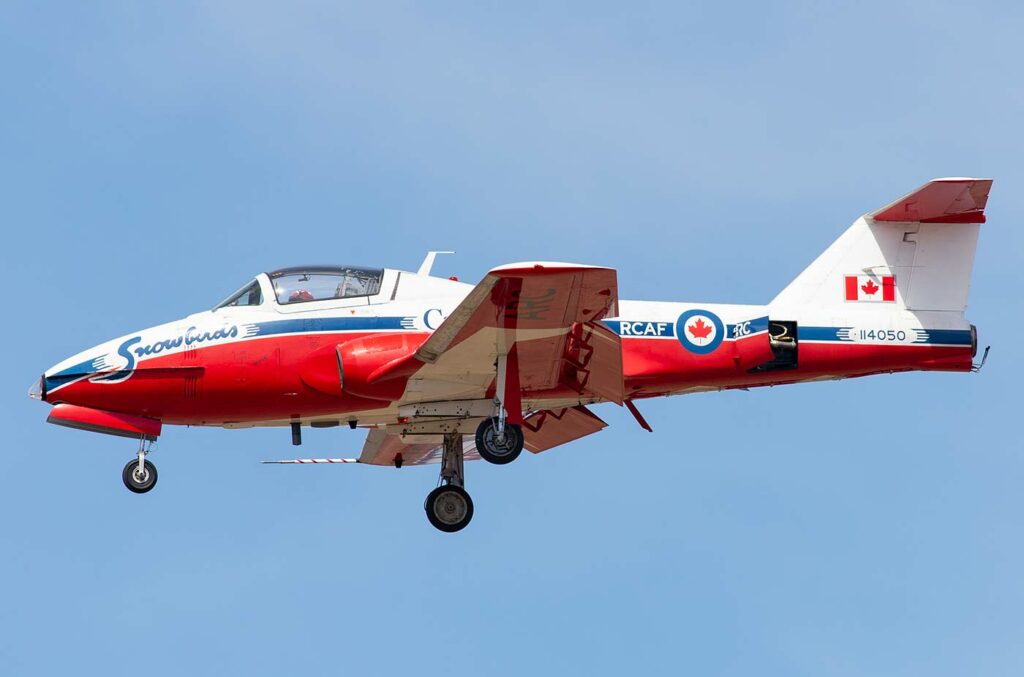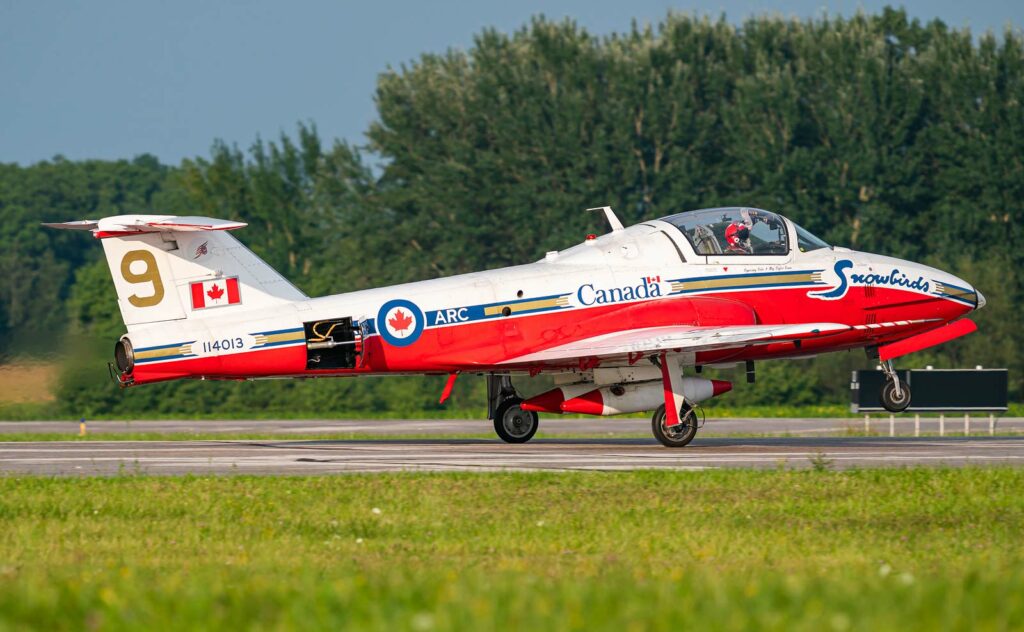The Canadair CT-114 Tutor, a Canadian-built jet trainer, was pivotal in pilot training and famed for its role with the Snowbirds aerobatic team.
In brief
The Canadair CT-114 Tutor is a jet trainer aircraft that served as the primary trainer for the Canadian Forces from the 1960s until the 2000s. Designed and manufactured by Canadair, it is a single-engine, straight-wing aircraft renowned for its maneuverability, straightforward design, and reliability. It has a top speed of 486 mph, a range of 944 miles, and a service ceiling of 36,000 feet. The Tutor was extensively used by the Canadian Forces Snowbirds aerobatic team, showcasing its capabilities in precision flying and aerobatic maneuvers. Its operational history spans several decades, reflecting its effectiveness in training generations of pilots in basic jet flight and aerobatics.

History of the Development of the Canadair CT-114 Tutor
In the context of the Cold War era, when jet technology was rapidly advancing, there was a pressing need for effective jet trainers that could adequately prepare pilots for the increasingly sophisticated frontline fighters. Canadair, a prominent Canadian aerospace manufacturer, responded to this need with the development of the CT-114 Tutor. The aircraft was specifically designed to meet the Royal Canadian Air Force’s (RCAF) stringent requirements for a new training platform that would replace the aging fleet of piston-engined trainers.
The development program for the Tutor was initiated in the late 1950s, marking a significant step in Canada’s aviation industry to support its military training infrastructure. The objective was clear: to create a jet trainer that was reliable, easy to maintain, and capable of providing a comprehensive training platform for pilots transitioning to high-performance jet aircraft. Canadair’s proposal was selected, and the company went on to develop an aircraft that would become synonymous with pilot training in Canada.
The CT-114 Tutor took its first flight on January 13, 1960, signaling the beginning of a new era in military pilot training. The aircraft was not given a specific NATO nickname, which is often the case with trainer aircraft. However, its designation and performance quickly made it a well-respected platform in aviation circles, especially within Canada, where it went on to serve as the backbone of the RCAF’s training fleet.
Design of the Canadair CT-114 Tutor
The Canadair CT-114 Tutor was designed with simplicity and efficiency in mind, attributes that made it an ideal training aircraft. It features a low-wing, straight-wing configuration that provides stable flight characteristics and good visibility from the cockpit, essential for training pilots. The aircraft is powered by a single J85-CAN-40 engine, producing 2,700 pounds of thrust, allowing it to achieve speeds up to 486 mph (782 km/h) and a service ceiling of 36,000 feet (10,973 meters).
The Tutor’s airframe is predominantly aluminum, which contributes to its light weight and durability. It has a wingspan of 36.5 feet (11.13 meters) and a length of 32 feet (9.75 meters), dimensions that ensure agility and responsiveness. The cockpit accommodates two crew members in a tandem seating arrangement, with the student pilot in the front and the instructor in the rear, both under a clear, bubble canopy that offers excellent visibility.
The design’s advantages include ease of maintenance and operational simplicity, making it an effective platform for pilot training. However, its conventional design and older technology also meant it lacked the advanced avionics and systems of newer trainer aircraft. Despite this, the Tutor brought significant value to pilot training programs, emphasizing fundamental flying skills and aerobatic capabilities.
Performance of the Canadair CT-114 Tutor
The performance of the CT-114 Tutor was tailored to meet the demands of a training aircraft while providing sufficient capability for aerobatic maneuvers and formation flying, as evidenced by its long service with the Snowbirds, Canada’s premier aerobatic team. The Tutor’s J85-CAN-40 turbojet engine, with 2,700 pounds of thrust, enabled a maximum speed of 486 mph (783 km/h) and a range of 944 miles (1,519 km) when equipped with external tanks. Its service ceiling reached 36,000 feet (10,973 meters), allowing trainees to experience operations at high altitudes.
In comparison to its contemporaries, the Tutor was not the most powerful or advanced jet trainer but was highly regarded for its reliability, ease of handling, and cost-effectiveness. These attributes made it an invaluable asset in the training environment, providing a solid foundation for pilots before transitioning to more advanced aircraft.
Variants of the Canadair CT-114 Tutor
The CT-114 Tutor had several variants, each designed for specific training or operational roles. The primary version was the standard CT-114 used for jet training by the Canadian Forces. Additionally, there was a dedicated aerobatic version modified for the Canadian Forces Snowbirds, featuring smoke generators and a more vibrant paint scheme to enhance its visibility during shows.
Another variant included the CT-114B, which was proposed for a navigation training role, equipped with different avionics and instrumentation. However, this variant was not widely adopted. The differences among the variants were primarily in their avionics, liveries, and specific modifications for aerobatic performance, with the fundamental airframe and engine remaining consistent across the models.
Military Use and Combat of the Canadair CT-114 Tutor
The CT-114 Tutor was predominantly used as a training aircraft rather than a combat jet. Its primary role was to provide basic and advanced jet training to pilots of the Canadian Forces, a mission it performed exceptionally over several decades. The aircraft was not armed and did not participate in combat operations; instead, its contribution to military efforts was in preparing pilots for operational readiness, which is a critical aspect of military effectiveness.
The Tutor gained international fame with the Canadian Forces Snowbirds, which used the aircraft for precision aerobatic performances, demonstrating the high level of skill and teamwork required in military aviation. While not a combat aircraft, the Tutor’s impact on military preparedness and public engagement has been significant.
The aircraft has not been exported widely, with its use primarily confined to Canada. As of its retirement from active training roles, the Tutor was replaced by more modern aircraft equipped with advanced technology to meet the evolving requirements of military aviation training. However, it remains in limited use, particularly with the Snowbirds, symbolizing its enduring legacy in the aviation community.

The Canadair CT-114 Tutor stands out as a significant contributor to military aviation training, emphasizing the importance of dedicated trainer aircraft in preparing pilots for the complexities of modern air combat. Its design, performance, and operational history reflect its value and effectiveness in a training role, leaving a lasting legacy in the field of military aviation.
Back to the Trainers section.